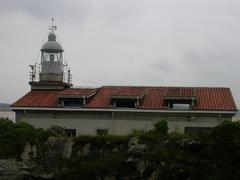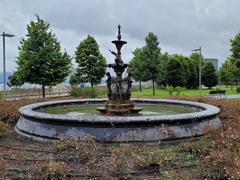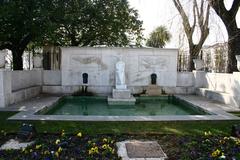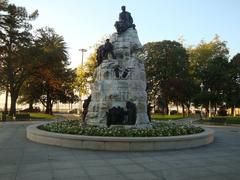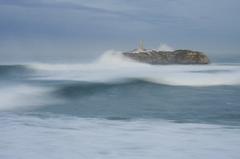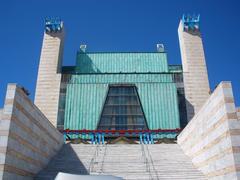
Monument to Velarde in Santander: Visiting Hours, Tickets, and Historical Significance
Date: 03/07/2025
Introduction
The Monument to Velarde in Santander is one of the city’s most emblematic landmarks, offering a window into Spain’s rich historical tapestry. Situated in the heart of Plaza Porticada (also known as Plaza Velarde), this imposing bronze statue pays tribute to Captain Pedro Velarde y Santiyán—a local hero and a central figure in the Dos de Mayo Uprising of 1808. His act of resistance against Napoleonic forces not only cemented his place in national memory but also established Velarde as a lasting symbol of Spanish resilience and patriotism. The monument’s prominence within Santander’s neoclassical city center underscores its significance, serving as both a focal point for civic events and a testament to the enduring spirit of Cantabria’s people (Santander Tourism; esculturaurbana.com; The Orange Backpack).
This in-depth guide explores the history, design, visiting logistics, and cultural context of the Monument to Velarde, providing everything you need to plan a meaningful visit.
Contents
- Origins of the Monument and Historical Context
- Artistic Design and Symbolism
- Urban Placement and Integration
- Visiting Hours, Tickets & Accessibility
- Guided Tours, Special Events, and Photography
- Cultural Functions and Community Life
- Connections to Other Monuments and National Heritage
- Practical Tips for Visitors
- Frequently Asked Questions (FAQ)
- Summary and Final Thoughts
Origins of the Monument and Historical Context
Pedro Velarde y Santiyán was born in Muriedas, Camargo (Cantabria) in 1779. As a distinguished artillery officer, he played a pivotal role in the events of May 2, 1808, when he and Captain Luis Daoíz y Torres led a valiant defense of the Monteleón artillery barracks during the uprising against Napoleonic occupation. Velarde’s death in this conflict made him a martyr of the Spanish War of Independence, and his legacy endures as a symbol of national resistance (Wikipedia: Pedro Velarde y Santiyán).
The monument was erected in 1880, decades after Velarde’s sacrifice, as part of a broader movement to honor national heroes and reinforce civic pride in Santander and beyond (esculturaurbana.com). Its location in a rebuilt square following the devastating 1941 city fire further connects Velarde’s memory to Santander’s spirit of renewal.
Artistic Design and Symbolism
Designed by Aranjuez-born sculptor Elías Martín Riesco and inaugurated on May 2, 1880, the monument is a striking example of academic realism from the late 19th century. Cast in bronze and standing approximately 9.5 meters tall, it depicts Velarde in full military regalia, radiating determination and leadership. His upright posture, extended arm, and sword symbolize defiance and the willingness to sacrifice for freedom.
The base of the monument is adorned with reliefs and inscriptions that narrate Velarde’s role in the Peninsular War, serving as both a focal point for public memory and a collective memorial to those who fought for Spain’s independence (escenasdesantander.blogspot.com). The use of bronze ensures the monument’s durability, while its detailed artistry invites reflection on themes of courage, patriotism, and sacrifice.
Urban Placement and Integration
Since 2007, the Monument to Velarde has stood at the center of Plaza Porticada, a neoclassical square reconstructed after the 1941 fire. The plaza’s design—with arcaded galleries, open sightlines, and inviting benches—encourages gathering, leisure, and cultural engagement (esculturaurbana.com). The monument’s central position makes it a key orientation point within the city and a natural meeting place for both locals and visitors.
Plaza Porticada is surrounded by historic landmarks, such as Santander Cathedral and the Mercado de la Esperanza, and is within easy walking distance of the waterfront and Pereda Gardens (turispanish.com). This urban integration ensures that the monument remains at the heart of Santander’s daily life and cultural routes.
Visiting Hours, Tickets & Accessibility
- Visiting Hours: The Monument to Velarde is located outdoors and is accessible 24/7. While you can visit at any time, daylight hours (especially late afternoon and early evening) offer the best lighting and ambiance.
- Tickets: There is no entry fee. The site is freely accessible to all.
- Accessibility: Plaza Porticada and the monument area are fully wheelchair accessible, with smooth, wide pathways suitable for visitors of all abilities. Benches are available for rest.
For visitors arriving by public transport, the plaza is a short walk from Santander’s main train and bus stations. Several car parks, such as Parking Alfonso XIII, are located nearby. Santander’s compact city center makes walking the most enjoyable way to explore (The Orange Backpack; Travel Notes and Things).
Guided Tours, Special Events, and Photography
- Guided Tours: The monument is frequently included in guided walking tours of Santander’s historical sites, particularly around the anniversary of the Dos de Mayo Uprising on May 2. These tours provide valuable historical and artistic context.
- Special Events: Plaza Porticada regularly hosts concerts, festivals, and civic ceremonies, with the monument often serving as a backdrop for commemorative events (tracesofwar.com).
- Photography: The harmonious architecture and dramatic bronze statue make this an excellent spot for photography. Early morning and late afternoon light are especially favorable.
Cultural Functions and Community Life
The Monument to Velarde is not only a memorial but also a lively part of Santander’s urban and cultural fabric. Plaza Porticada serves as a venue for open-air performances, festivals, and public celebrations, making the monument a living part of the city’s identity (Santander Tourism). During commemorations like Dos de Mayo, the plaza becomes a gathering point for ceremonies and educational activities, reinforcing community bonds and historical awareness.
Connections to Other Monuments and National Heritage
The Monument to Velarde in Santander is part of a broader network of memorials dedicated to the heroes of the Dos de Mayo Uprising. Notably, the Monument to Daoiz and Velarde in Segovia features more elaborate sculptural depictions of the same historical events (Wikipedia: Monument to Daoiz and Velarde (Segovia)). Together, these monuments highlight the enduring significance of Velarde and his contemporaries in Spain’s national consciousness.
Practical Tips for Visitors
- Cafés and Amenities: Several cafés and restaurants with outdoor terraces surround Plaza Porticada, providing a perfect break during your visit. Public restrooms are available in nearby markets and cafés.
- Weather: Santander’s coastal climate is generally mild, but it can be unpredictable. Bring a light jacket or umbrella, especially outside the summer months (Spain.info).
- Language: While English is increasingly spoken, learning a few basic Spanish phrases can enhance your experience.
- Nearby Attractions: Combine your visit with stops at Santander Cathedral, Mercado Municipal del Este, Pereda Gardens, and the waterfront promenade.
Frequently Asked Questions (FAQ)
Q: Are there entrance fees or tickets required to visit the Monument to Velarde?
A: No, the monument is in a public square and is free to visit 24/7.
Q: Are guided tours or audio guides available at the monument?
A: Many Santander walking tours include the monument as a stop, though there are no on-site audio guides.
Q: Is the Monument to Velarde accessible for visitors with mobility challenges?
A: Yes, the plaza’s flat, paved surfaces and wide entrances make it wheelchair and stroller accessible.
Q: Can I take photographs with a tripod at the monument?
A: Tripods are generally permitted; please be considerate of pedestrian traffic, especially during busy times.
Q: When are the main commemorative events held?
A: The most significant event is the annual Dos de Mayo commemoration on May 2.
Summary and Final Thoughts
The Monument to Velarde stands as a beacon of Spanish courage, patriotism, and resilience, beautifully integrated into the urban heart of Santander. Its accessible location, commanding presence, and vibrant surroundings make it an essential stop for anyone seeking to understand the spirit of Cantabria and the legacy of Pedro Velarde. Whether you come for the history, the art, or the lively atmosphere of Plaza Porticada, this monument invites reflection and connection with Spain’s national story.
For up-to-date information on events, guided tours, and travel tips, consult official tourism resources or use the Audiala app to enhance your experience (Official Santander Tourism Website; esculturaurbana.com; The Orange Backpack).
Further Reading and Official Sources
- Pedro Velarde y Santiyán, Wikipedia
- Monument to Velarde, esculturaurbana.com
- Santander Travel Guide, HollyMelody
- Statue of Pedro Velarde y Santillán, tracesofwar.com
- Santander City Culture, Santander Tourism
- Best Things to Do in Santander, The Orange Backpack
- Santander Spain Travel Guide, turispanish.com
- Is Santander Worth Visiting?, Travel Notes and Things
- Monument to Daoiz and Velarde (Segovia), Wikipedia
Images and media are recommended to accompany this article, with alt text such as “Monument to Pedro Velarde in Santander’s Plaza Porticada” for accessibility and SEO.






